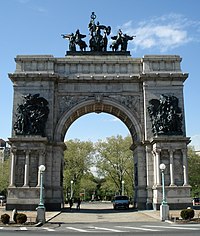Grand Army Plaza
| Grand Army Plaza | |
|
|
| landmark | |
|
The Soldiers' and Sailors' Arch at the south end of the traffic oval (foreground).
|
|
| Country | United States |
|---|---|
| State | New York |
| Borough | Brooklyn, New York City |
| Part of | Prospect Park (Brooklyn) |
| Location | John F. Kennedy memorial |
| - elevation | 131 ft (39.9 m) |
| - coordinates | 40°40′27″N 73°58′13″W / 40.6743°N 73.9702°WCoordinates: 40°40′27″N 73°58′13″W / 40.6743°N 73.9702°W |
| Area | 14.26 acres (6 ha) |
Grand Army Plaza, originally known as Prospect Park Plaza, is a public plaza that comprises the northern corner and the main entrance of Prospect Park in the New York City borough of Brooklyn. It consists of concentric oval rings arranged as streets, with the namesake Plaza Street comprising the outer ring. The inner ring is arranged as an ovoid roadway that carries the main street – Flatbush Avenue – with eight radial roads connecting: Vanderbilt Avenue; Butler Place; Saint John’s Place (twice); Lincoln Place; Eastern Parkway; Prospect Park West; Union Street; and Berkeley Place. The only streets that penetrate to the inner ring are Flatbush Avenue, Vanderbilt Avenue, Prospect Park West, Eastern Parkway, and Union Street.
The plaza includes the Soldiers' and Sailors' Arch, the Bailey Fountain, the John F. Kennedy Monument, statues of Civil War generals Gouverneur K. Warren and Henry Warner Slocum, busts of notable Brooklyn citizens Alexander J.C. Skene and Henry W. Maxwell, and two 12-sided gazebos with "granite Tuscan columns, Guastavino vaulting, and bronze finials".
Originally, the grounds of the Grand Army Plaza was a battleground of the Battle of Long Island, which was the first battle of the American Revolution.
The 1861 plan for Prospect Park included an elliptical plaza at the intersection of Flatbush and Ninth avenues. In 1867, the plaza was designed by Frederick Law Olmsted and Calvert Vaux as a grand entrance to the Park to separate the noisy city from the calm nature of the Park. Olmsted and Vaux's design included only the Fountain of the Golden Spray and the surrounding earth embankments covered in heavy plantings. The berms still shield the local apartment buildings and the main branch of the Brooklyn Public Library from the noisy traffic circle that has developed. By 1869 the by Henry Kirke Brown was north of the plaza fountain's stairs, and the statue was moved to the lower terrace of the park's Concert Grove in 1895.
...
Wikipedia


